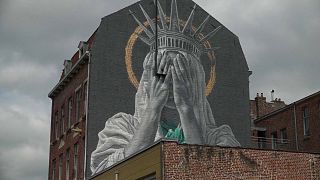France
Blue jeans are arguably the most common and popular clothing item that can be seen worn around the world.
All-purpose, inter-generational, timeless and comfortable. Jeans today have become a fashion victim of their own success as the garment is now a symbol of over-consumption or "fast-fashion," -- the textile side of fast food.
- What Style of Jeans Do You Wear? -
As such, a pro-green fashion history exhibition which opened on Wednesday at the Cités des Sciences et l'industrie in Paris explores the flipside of our beloved denim wear -- revealing how the production of jeans unfortunately highly pollutes our planet.
Exhibition curator Sophie Lécuyer shares historical details on the subject and explains why she feels jeans succeeded in becoming so popular worldwide.
"We know when jeans were first made: 1872 with Levi Strauss and Jacob Davis. They created a piece of cloth to work with, something very robust and strong because it was made for gold prospectors.
"And what did they want? A pair of trousers that can't be destroyed when tools are placed in the pockets. So from the start, it's really workwear, it was called overalls which means you can wear it over regular clothes."
"From workwear, jeans gradually became leisurewear and youth wear, which almost all cultures have seized upon: hippies, punks, rockers, rappers... Because it represents the identities of each person and allows each generation to express itself."
Although historians do not all agree on the exact origin of blue jeans, it is certain that enslaved African-Americans picking cotton on field plantations in 19th-century United States enabled the production of the strong, stiff and inexpensive, denim fabric.
Sophie Lécuyer explains the makeup of the average pair of jeans.
"Blue jeans are made out of cotton, with a weave called sergé, with a colour that is often blue, but we can also find black jeans or other colours, but most of them have these features: five pockets, stitching and rivets. Blue jeans are all of this, it is not only a matter of fabric, but it is also all these features -- including rear pockets and patches."
The tilled cotton fields by enslaved African-Americans greatly contributed to the growth of the cotton industry.
The cotton-made denim fabric itself has since crossed the Atlantic during the Second World War -- to spread around the world in less than a century and has now become a universal wardrobe staple.
But apparently, every stage of the intricacies of the complex jean production process is still problematic i.e. polluting pesticides for intense cotton farming, huge water irrigation for indigo dyeing and sub-par exploitative work conditions for weavers in Asia -- as China, India and Bangladesh are where most jean fabrication has since been relocated.
- "Another pair of jeans" -
The exhibition 'Jean' tells the story of how in the 1960s, French designers Marithé and François Girbaud developed a process to age the fabric (to make it less stiff) with pumice stones in a washing machine. This method of washing, as it became industrialised, turned out to be "an ecological disaster in view of the enormous quantities of water required", according to the curator.
The same duo then invented a cleaner way of 'ruining' jeans: the laser method, which is used today.
Because yes, "another pair of jeans is possible". On the condition that manufacturers and consumers are responsible, we are told. There are short circuits, reliable channels, less polluting textiles such as linen, hemp and even nettle!
The Parisian exhibition exposes it all -- teaching visitors all they need to know about the fabric, its history, its evolution and how some new designers are trying to make blue jeans that are a bit more environment-friendly.
The visual journal also invites us down the path of “clean jeans” that are not only better for our planet but also includes conscious messaging and tips to improve our own jean-purchasing and wearing habits as consumers.
You can also reduce the number of jeans in your wardrobe and recycle used ones properly. So much advice to ponder on a special denim playlist concluding the visit, a tune by David Bowie ("Blue Jean"), or Adamo ("En blue jean et blouson de cuir").
Jean, the Parisian exhibition that explores this versatile garment which sees 73 pairs sold each second around the world, will remain open to the public until January 2022.











01:17
UNESCO inscribes 26 new sites on World Heritage list
01:00
Stolen Roman mosaic with erotic motif returned to Pompeii after WWII
01:05
Pharrell Williams presents Spring/Summer 2026 collection for Louis Vuitton
Go to video
Sustainability in vogue at Casablanca's Style and Tex show
Go to video
Restored Havana Convent Becomes School to Train Youth in Heritage Conservation
02:18
Togo international fashion week focus on breast cancer prevention